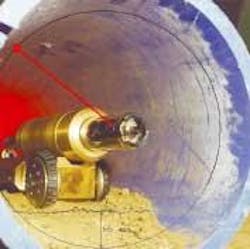
Pipes, conduits, tubes, and ducts—the innards of the man-made world—often need monitoring as they age. Although cameras or light-striping systems have been used to examine the insides of pipes, such systems typically do not give precise metric information on the pipes' inside profile. Tim Clarke of the Optical Metrology Centre (OMC; Bishop's Stortford, England) has developed and commercialized a laser profiler with a rotating probe that can profile internal shapes from 140 to 480 mm in diameter to a resolution of 0.1 mm and an accuracy of between 0.1 and 0.8 mm (the accuracy depends on the inner diameter of the pipe being profiled). The profiler, which can be mounted on a motorized tractor unit, has already drawn interest from the military, water, waste, and offshore oil and gas industries (see figure).
Based on laser triangulation, the instrument's probe is rotated through 360∞ as its angular position is measured with an optical encoder. The source itself is a 670-nm-emitting Class II laser diode. Measurements are taken at up to 1000 data points per second, with a typical profile consisting of 500 to 2000 data points taken over three seconds. Variations in reflectance or color are automatically taken into account. The profiler contains an inclinometer so that its scans can be properly referenced to vertical. The device has been tested in pipes and cavities of steel, plastic, clay, cast iron, and concrete, as well as in epoxy-coated structures.
Flaws in pipes can include out-of-roundness (in fabrication or from later deformation), cracks, cavitation, wear, and corrosion—all of which can be measured with the OMC device. If "before" and "after" profile measurements are taken, the difference between the measurements can indicate the extent of pipe deformation over a period of time, or the thickness of applied coatings. Plastic pipes can be surveyed to assess whether the pipe has been bent too much, which could lead to future problems. The profiler is potentially useful in the measurement of shapes other than circular, such as rectangular ducting or molds and in quality control of key features in manufactured components.
The recent first sale of the profiler—to an offshore oil and gas company—was aided by the wealth of test data from the preproduction model, says Clarke. "The data gave very useful information about the shape of typical steel pipes, which deviate from circularity by quite a bit," he notes. The preproduction version was developed and tested in conjunction with Thames Water (Swindon, England), a utility company recently purchased by RWE (Essen, Germany)—Germany's second-largest utility, which provides electricity, gas, water, and recycling. "We are expecting that the laser-profiling tool will be of use in the process industry, production engineering, and the nuclear industry as well as for current users," says Clarke.
About the Author
John Wallace
Senior Technical Editor (1998-2022)
John Wallace was with Laser Focus World for nearly 25 years, retiring in late June 2022. He obtained a bachelor's degree in mechanical engineering and physics at Rutgers University and a master's in optical engineering at the University of Rochester. Before becoming an editor, John worked as an engineer at RCA, Exxon, Eastman Kodak, and GCA Corporation.
